Visual programming languages have never taken off because no one has done it right yet. In the same way that C++ / visual studio were the right technology for people at the time of their advent.
However, the age of talking to our machines (Alex voice service), and programming with nicer tools than text editors is upon us.
Here's the start of one I'm working on. I'm trying to bootstrap my project since if you're making a cool programming tool, why wouldn't the tool itself eventually be written in the tool's input language. I did start out at first by rendering my own graphs with PyQt5 / QGraphicsScene but debugging a 2D scene is actually extremely hard - that is unless you have a visual graph to program with instead! So rendering my own graph and writing the graph editor comes after I can get basic graphs to run. My favorite general purpose graph editor is yEd. It outputs .graphml which is good because the networkx library for python can already read in .graphml (Only problem is loading in the graph colors + other properties than position; so feature will wait til we are doing our own graph drawings).
Here is an example input graph:

Here's some basic code to run it:
import networkx as nx
from PyQt5.QtCore import QThread, QObject, pyqtSignal
from PyQt5.QtGui import QColor
from PyQt5.QtWidgets import QApplication, QMainWindow, QPushButton
import re
import sys
EDAT = 2
NDAT = 1
class CodeGraphThread(QThread):
ifRgx = r'^if\s+(.+)\s*$'
elseRgx = r'\s+|^$'
def __init__(self, graph, parent=None):
super(CodeGraphThread, self).__init__(parent)
self._nodes = {}
self.setGraph(graph)
self._retVal = None
self._locals = []
def setGraph(self, graph):
self._graph = graph
G = graph.G()
nodes = [x for x in G.nodes(data=True) if x[NDAT]['label'] == 'start']
if nodes: self._setStart(nodes[0][0])
def _setStart(self, nstr):
self._nodes['start'] = nstr
def start(self):
self._running = True
self._nodes['current'] = self._nodes['start']
QThread.start(self)
def _exec(self, codeText):
try:
exec('self._retVal=' + codeText)
except:
try:
exec(codeText)
except:
self.codeGraph().errorMessage.emit('Coudln\'t execute code: "' + codeText + '"')
def returnVal(self):
return self._retVal
def run(self):
while self._running:
cg = self.codeGraph()
G = cg.G()
current = self._nodes['current']
#TODO transfer over to regex system
data = [d for x,d in G.nodes(data=True) if x == current and 'label' in d and d['label'] not in ['start']]
if data:
codeText = data[0]['label']
self._exec(codeText)
rgx = self.ifRgx
edges = cg.edgesFr(current, rgx)
if edges:
e= edges[0]
ifArg = cg.matches(rgx).group(1)
self._exec(ifArg)
if self.returnVal():
self._nodes['current'] = e[1]
continue
rgx = self.elseRgx
edges = cg.edgesFr(current, rgx)
edges += cg.edgesFr(current, None)
if edges:
e = edges[0]
self._nodes['current'] = e[1]
continue
break
def codeGraph(self):
return self._graph
class CodeGraph(QObject):
errorMessage = pyqtSignal(str)
statusMessage = pyqtSignal(str)
_rgxMemo = {}
def __init__(self, gmlpath=None):
QObject.__init__(self)
if gmlpath != None:
self.loadGraphML(gmlpath)
else:
self._gmlpath = None
self._G = nx.MultiDiGraph()
self._thread = CodeGraphThread(self)
def G(self):
return self._G
def loadGraphML(self, gmlpath):
self._gmlpath = gmlpath
self._G = nx.read_graphml(gmlpath)
def saveGraphML(self, gmlpath):
self._gmlpath = gmlpath
nx.write_graphml(self._G, gmlpath)
def debugPrintNodes(self):
print(self._G.nodes(data=True))
def debugPrintEdges(self):
print(self._G.edges(data=True))
def matches(self, rgx):
if rgx in self._rgxMemo:
return self._rgxMemo[rgx][1]
return None
def rgx(self, rgx):
if rgx not in self._rgxMemo:
self._rgxMemo[rgx] = [re.compile(rgx), None]
return self._rgxMemo[rgx][0]
def rgxMatch(self, rgx, string):
if rgx not in self._rgxMemo:
rgx_ = self.rgx(rgx)
else:
rgx_ = self._rgxMemo[rgx][0]
match = self._rgxMemo[rgx][1] = rgx_.match(string)
return match
def edgesFr(self, n0, rgx):
if rgx != None:
return [(u,v,d) for u,v,d in self.G().edges(data=True) if u == n0 and 'label' in d and self.rgxMatch(rgx, d['label'])]
else:
return [(u,v,d) for u,v,d in self.G().edges(data=True) if u == n0 and 'label' not in d]
if __name__ == '__main__':
cg = CodeGraph('unnamed0.graphml')
cgthread = CodeGraphThread(cg)
def printError(errorMsg):
print(errorMsg)
cg.errorMessage.connect(printError)
# Qt application reqd for QThread testing
app = QApplication(sys.argv)
win = QMainWindow()
win.setWindowTitle('PyGraphML Practice 0')
button0 = QPushButton('Start thread running')
button0.clicked.connect(cgthread.start)
win.setCentralWidget(button0)
win.show()
sys.exit(app.exec_())
Current issues: Python 3 doesn't handle exec / locals() well (hence use of self.x instead of just x), so thinking of using a 3rd-party python interpreter or just statically modifying the code.
Not saying that my tool does anything right yet. For things to be done right, there also must be auto-refactoring tools, debugging, etc.
